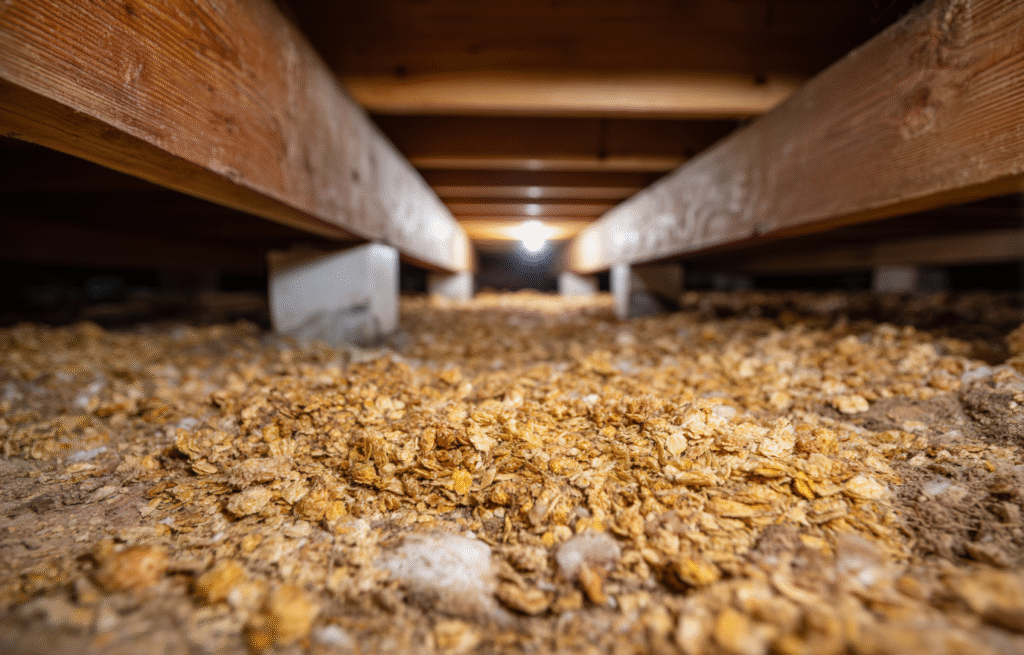Floor Joist Damage Causes

Floor joist damage is often indicated by sagging floors, bouncy floors, or wood rot in a crawl space. Heavy furniture, pest infestations, and pest damage can create structural damage, but proper repair methods can restore safety.
Floor joist damage solutions for a safer, stronger home.
Floor joist damage causes are a common issue for many homeowners, especially in older houses or those with unprotected crawl spaces. Understanding the floor joist damage is key to protecting structural integrity and avoiding costly repairs. At Appalachian Foundation Services, we identify the problems early, apply practical solutions to restore stability, and prevent future damage. Call us today to schedule your professional inspection and take the first step toward a safer, stronger home.
General Cause & Problem Questions
What causes floor joist damage in a house?
Floor joists can be compromised by moisture exposure, foundation movement, poor ventilation, or pest infestations. Excess moisture in a crawl space often accelerates wood rot, while foundation issues may cause cracks or spacing problems in beams. When these issues are left unchecked, they weaken the structural components, creating conditions for further damage and long-term structural issues.
What are the most common issues with floor joists?
Can termites cause floor joist damage?
Yes, termites and carpenter ants are notorious for causing pest damage that weakens wood and undermines flooring support. Pest infestations silently eat away at joists, leading to structural damage over time. Without timely inspections, the underlying cause of damage may remain hidden until major repairs are necessary.
How does water affect floor joists?
Moisture exposure from plumbing leaks, basements, or blocked drainage often leads to wood rot and mold. Water damage reduces stability and may allow rot or decay to spread into beams and subfloors. If ignored, structural damage escalates, creating safety risks and costly repair methods to restore support.
Signs & Symptoms Questions
What leads to floor joist failure over time?
How can I tell if my floor joists are damaged?
What are the signs of rotten floor joists?
Do squeaky or uneven floors mean floor joist damage?
How do I know if my floor joists are sagging?
Structural & Safety Questions
Is floor joist damage dangerous?
Yes, ignoring floor joist damage can compromise safety. Weak joists reduce overall stability and create a risk of collapse. Failing to maintain these structural components can result in structural damage that jeopardizes the safety of your house and family.
Can damaged floor joists cause a house to collapse?
In severe cases, yes. A damaged joist or series of breaks may undermine stability, leading to structural collapse. Without reinforcement, there is a risk of further cracks, slope, or uneven flooring spreading throughout the floor system. Professional repair is required to restore stability and reinforce support beams.
How serious is water damage to floor joists?
Water damage accelerates decay and weakens structural components, making the issue progressively worse if not addressed. Rot, mold, and moisture damage compromise beams and joists, creating costly repairs. Sistering, reinforcement, or complete replacement may be necessary to restore support and maintain value.
Can floor joist problems affect home resale value?
Repair & Prevention Questions
How do you repair damaged floor joists?
Repairing joists often involves reinforcement with steel beams, sistering new wood to damaged sections, or complete replacement. Repair methods depend on the underlying cause, whether it’s moisture, pest infestations, or foundation issues. Professionals use bolts, reinforcement systems, and encapsulation strategies to restore support.
Can rotten floor joists be replaced?
Yes, rotten joists can be replaced with new lumber. Replacement restores stability and prevents collapse. Reinforcement strategies may include sistering or spacing adjustments to preserve safety and maintain the structural integrity of the house.
What’s the cost to repair floor joist damage?
Costs vary depending on the severity of the damage and whether replacement or reinforcement is required. Repair costs can rise if multiple beams or subfloor sections must be replaced. Contacting a foundation repair specialist ensures accurate estimates and avoids mistakes that can lead to more damage.
How can I prevent floor joist rot?
Preventing rot involves controlling moisture exposure in the crawl space, sealing plumbing leaks, and regularly inspecting for warning signs. Encapsulation, vapor barriers, and blocked ventilation fixes help maintain stability. Protecting joists preserves the structure and reduces the risk of rot, mold, or pest infestations.
Should I encapsulate my crawlspace to protect joists?
Yes, encapsulation is one of the most effective long-term strategies for protecting and preserving joists. Installing a vapor barrier in the crawl space reduces moisture, mold growth, and excess humidity. Encapsulation helps maintain reinforcement, spacing, and support, safeguarding your home’s structural integrity.
Customer Testimonials
How did Appalachian Foundation Services help with my floor joist damage?
“They did a fantastic job diagnosing the warning signs and quickly fixing the sagging floors in our crawl space. The team explained everything clearly and used professional repair methods to restore stability. I couldn’t be happier with the results.” – Jeffrey M.
Can Appalachian Foundation Services really fix wood rot and pest damage in joists?
“Yes! They replaced damaged joists affected by wood rot and pest infestations, and reinforced my floor system so it felt like new again. No more bouncy floors, and I finally feel safe in my home.” – Joy R.
Was it worth calling them for structural damage?
“Absolutely. I had heavy furniture causing sagging floors, and the technicians at Appalachian Foundation Services identified the floor joist damage causes right away. Their repair methods preserved my home’s value and prevented more structural damage down the line.” – Diana Mae K.
Protect Your Home Today
Even minor floor joist damage can grow into serious threats that compromise safety, reduce property value, and create costly repairs. At Appalachian Foundation Services, we specialize in identifying the root causes, applying proven repair methods, and protecting your home against hidden crawl space and flooring dangers. Don’t wait until sagging floors or wood rot get worse—call us today for a free consultation and let our team address your floor joist damage causes, restore stability, prevent future structural damage, and give you lasting peace of mind.
